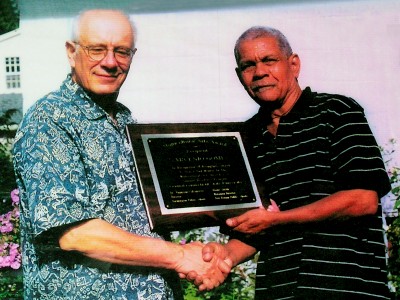|
|
|
Señor Gomez, how you do that? |
Señor Gomez Speaks on Mas'
 Mr. Gomez being honoured at Connecticut University
Mr. Gomez being honoured at Connecticut University
Pages: 01 | 02 | 03 | 04 | 05 | 06 | 07 | 08 | 09 | 10 | 11 | 12 | 13 | 14 | 15
Staff Article
Interview Recorded: May 15, 2005
Posted: June 12, 2005
Carnival bodies honored me
All the Carnival bodies honored me. The Queens Park Savannah, Downtown and across the bridge here. The only thing I did not get something for is Uptown, and as you see on my wall the awards are from home and abroad. My first award I got was in Barbados. We brought the bandleader from a T-Shirt band and we started coming second Band of the Year. After we had the second year, the fella invited me to the band celebrations and he sent a ticket for me and they gave me a plaque. He opened the way for all the plaques here. At that time the guy who was the Secretary of the Carnival Association said, "This man say he never get a certificate." Gomez, Errol Payne, Terry Evelyn and he started to call names. He said they would have to see about that. When I got the plaque from Barbados there was no stopping, it opened the way; the floodgate. Then there is one from Pantrinbago for contributing to the art form and the culture.
My first assignment outside was in Barbados. I cannot say Venezuela was my first because I went to live there. My second one was in Nashford Trinity College with Minshall and Chalkdust; a real beautiful thing. They took me there to make the different characters like the Fancy Sailor, the Bat and the Clown. I did a wonderful job and that is why I am still here. I go there every year but I go there now and stay at Connecticut University where they have a summer class, a multicultural programme. I can remember once the sculptor of the University came and told me, "Mr. Gomez if I could do this thing like how you are doing it my work would be easier." She was the sculptor and she saw the way I would bend a bird or an animal and others. She asked me, "How you do that, where was the picture?" I told her in my head. When we have to bend a lion we are not looking for any picture. She said that was marvelous.
My job was to teach the smaller children in the morning session and teach again in the evening time. I used to go to different groups like the Puerto Ricans, the Africans and the underprivileged children; it was nice. I am still here and as you can see I am being honoured and the only person today that got one of these awards. Every year they call me, and last year they spoke to me and asked when I wanted to come up. They paid my passage and they carry me all about. I would spend about three to four months but their programme is about five weeks. You would not believe how the children learn out there. You teach them the wirework or whatever you teach them they are learning. Like everything else, to start is a problem. For instance I went to a Puerto Rican neighbourhood and they wanted me to forget the wire. Then I saw that they had some containers and I took it and I started to make some butterflies and everybody went home with a brooch. Some made things like scenery with coconut trees. They said, "But we have this thing all the time." I said, "Yes but you do not have the expert and that is why I am here." Another thing I saw when I went to another neighbourhood, and there was a nice little booklet made up on wire skills. I thought it was something interesting. When I looked good, it was all the things I taught a Jamaican lady, and she did not even mention my name.
What had happened was, she started to make a horse head, but she had it in the book up to where I made it, I was making it here and she took it. When I told the Puerto Rican teacher it was my work, she said, "No, that is the lady from Jamaica who teaches here." I told her no and that I would finish the head to let her see that it was my work. I told her not to tell the lady anything, not to create a problem. She asked, "But how she could say she did it?" But that's the way it goes. It did not take away anything because I finished it.
I would go to about six different communities in the evening spending two hours here and there, because remember I had to say my thing in the University, and we would start from 8am to 3pm. Then they would send me by another school, and so on. They had their Carnival there and it was going, then we came, and there was another guy in New York that used to make some costumes. Then there was also a lady who had an American West Indian dance group and that too was beautiful. We started working and there is no regret, because I was always well treated and honoured. There was always a gift ... it was always, "When are you coming back?"
Continue...
Pages: 01 | 02 | 03 | 04 | 05 | 06 | 07 | 08 | 09 | 10 | 11 | 12 | 13 | 14 | 15
|

|
